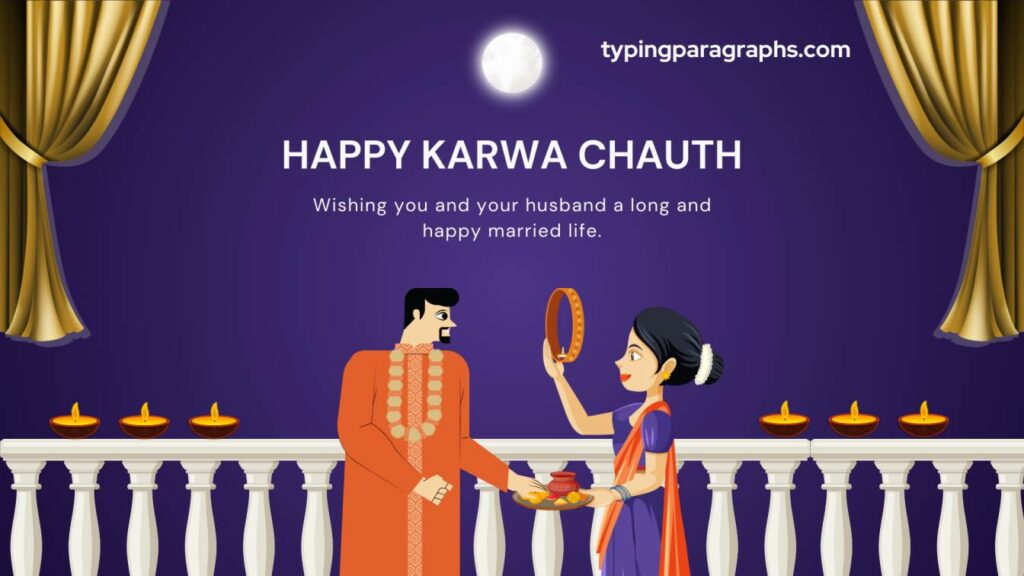“Karva Chauth: A Celebration of Love, Devotion, and Sacred Bonds”
Karwa chauth 2024 date :– Sun, 20 Oct, 2024, 6:46 am – Mon, 21 Oct, 2024, 4:16 am

You can copy this text, paste it into Notepad, save it, and add it to your typing tutor
Karva Chauth, a traditional Hindu festival celebrated primarily by married women in North India, holds profound significance as a symbol of love, devotion, and the sanctity of marriage. Rooted in ancient customs, cultural traditions, and religious beliefs, Karva Chauth is observed with great reverence and enthusiasm as women fast from sunrise to moonrise for their husbands’ longevity and good health. With its rituals, customs, and heartfelt prayers, Karva Chauth exemplifies the enduring bond between husband and wife and the timeless values of sacrifice, commitment, and love.
The origins of Karva Chauth can be traced back to ancient Hindu mythology and folklore, which narrate tales of the devotion and sacrifice of women for the welfare of their husbands. According to legend, the goddess Parvati, consort of Lord Shiva, observed a strict fast on Karva Chauth to ensure the longevity and prosperity of her husband. Inspired by her devotion, other women began to emulate her example, fasting on Karva Chauth and performing rituals to pray for the well-being and protection of their husbands. Over time, Karva Chauth became a widely celebrated festival marked by rituals, customs, and traditions that reflect the deep-seated reverence and devotion of married women towards their spouses.
Preparations for Karva Chauth begin days in advance, as women shop for new clothes, jewellery, and decorative items to adorn themselves for the occasion. Markets and bazaars bustle with activity as vendors sell colourful bangles, intricately designed mehndi (henna) cones, and decorative kavas (pots) used in the rituals of Karva Chauth. Married women exchange gifts and sweets with their mothers-in-law and sisters-in-law as a token of affection and goodwill, strengthening family bonds and fostering a sense of unity and solidarity.
The day of Karva Chauth begins before dawn, as women rise early to perform ablutions and dress in their finest attire, symbolizing their dedication and commitment to their husbands. They observe a strict fast, abstaining from food and water from sunrise to moonrise, as a sign of their love and devotion. The fast is broken only after sighting the moon in the evening sky, following which women partake in a ceremonial meal known as “sargi,” which typically includes sweets, fruits, and other delicacies.
The centrepiece of Karva Chauth rituals is the “puja,” or worship ceremony, performed in the late afternoon or early evening by married women in groups or individually at their homes. They gather around a decorated karva (pot) containing water, betel nuts, coins, and other auspicious items and offer prayers to the moon, seeking its blessings for the well-being and longevity of their husbands. The recitation of sacred hymns accompanies the puja, the lighting of lamps, and the exchange of heartfelt prayers and blessings among women, symbolizing the collective strength and support of the sisterhood.
As the evening progresses, women eagerly await the sighting of the moon, which marks the culmination of their fast and the fulfilment of their prayers. When the moon finally appears in the sky, women offer water to the moon and seek its blessings by looking at it through a sieve or the leaves of a sacred tree. They then turn towards their husbands and receive their blessings, symbolizing the mutual love, respect, and gratitude that define the holy bond of marriage.
Karva Chauth is a religious observance and a celebration of the enduring bond between husband and wife. Couples come together to express their love, appreciation, and gratitude for each other. Husbands often shower their wives with gifts, flowers, and tokens of affection, acknowledging their partners’ sacrifices and devotion. Families gather for festive meals and gatherings, sharing laughter, stories, and blessings, strengthening familial ties and fostering a sense of belonging and unity.
In addition to its religious and cultural significance, Karva Chauth holds social importance as well. It provides an opportunity for women to come together and support each other in their shared journey of married life. Women form bonds of friendship and camaraderie as they fast and pray together, sharing their joys, sorrows, and aspirations for the future. Karva Chauth also serves as a time for reflection and introspection as women contemplate the significance of marriage, family, and the enduring values of love, loyalty, and companionship.
As the festivities of Karva Chauth draw to a close, women gather to offer prayers of gratitude and thanksgiving, expressing appreciation for the blessings of love, companionship, and togetherness that enrich their lives. They break their fast with joy and anticipation, rejoicing in fulfilling their prayers and strengthening their marital bond. With hearts filled with love and devotion, married women bid farewell to Karva Chauth, carrying the blessings of happiness, harmony, and eternal love it embodies.
In conclusion, Karva Chauth is more than just a festival; it celebrates the sacred bond between husband and wife and the enduring values of love, devotion, and sacrifice. Karva Chauth exemplifies married women’s profound reverence and dedication towards their spouses and the timeless ideals of commitment, loyalty, and companionship through its rituals, customs, and traditions. It is a time to cherish the blessings of marriage, express gratitude for the gift of love, and reaffirm the sacred vows that unite hearts and souls in a lifelong journey of partnership and togetherness.”
How to Type Faster: A Comprehensive Guide to Improving Your Typing Speed
8 Enhancing Typing Skills: Building Muscle Memory for Efficient Typing


One Comment